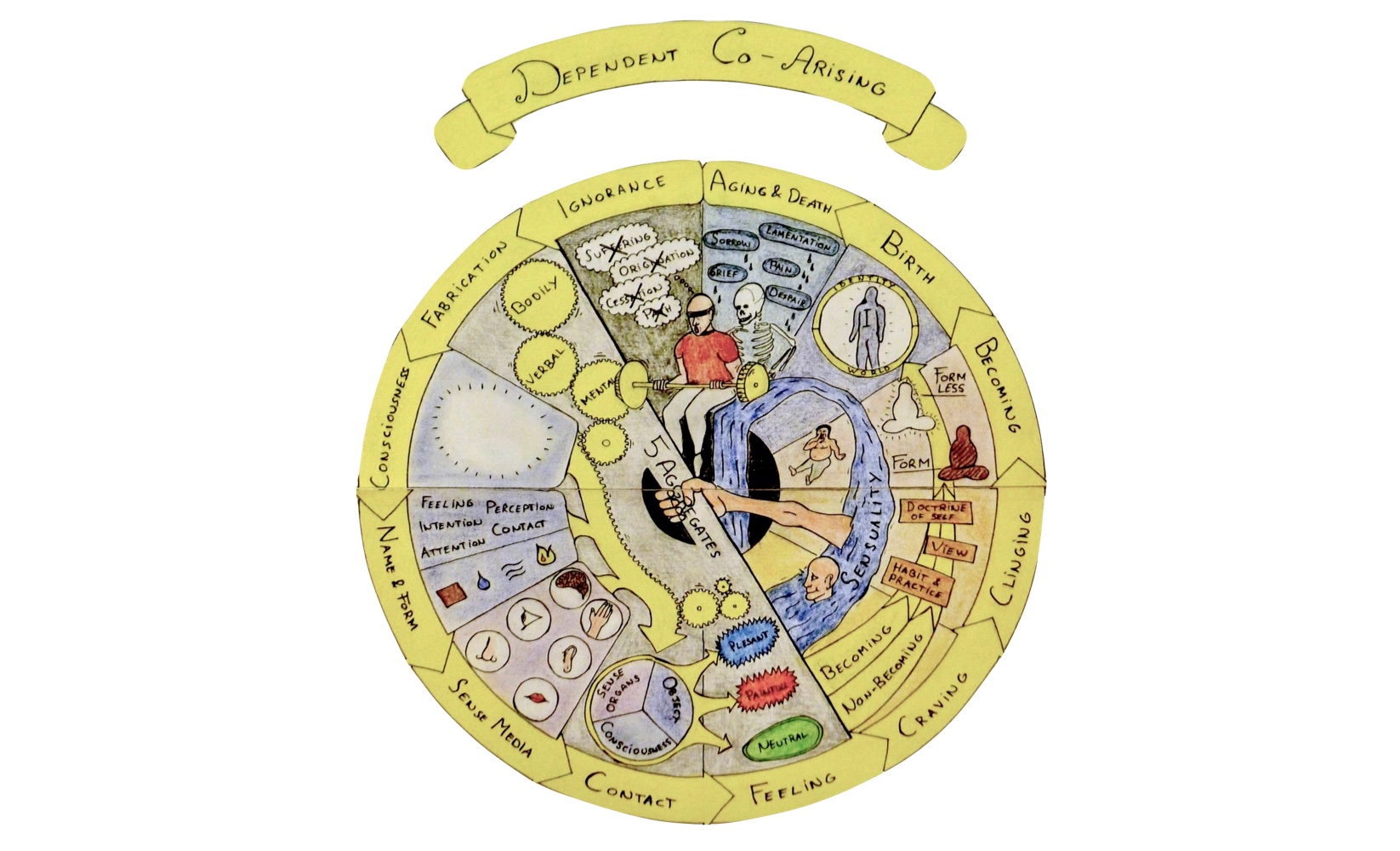Dependant Origination

Overview of Dependant Origination
Dependent origination is a teaching about how delusion causes the belief in the world, in things and states, in birth and death, in a self. The steps are instantaneous, not separated by time. One is the other.
Ignorance
We do not see the actual nature of being, which is unfabricated, unconditioned, unborn. Buddha says what is here is beyond being a something or a nothing. Not "it exists", not "it doesn't exist".
Fabrication
From that ignorance comes the belief that "things" actually exist. We make "things", this is why it's called a fabrication. It could be called a volitional activity.
Consciousness
Consciousness means to cognize in the suttas, to be aware of. It is a verb, not a noun. Mistaking formations for what is real, we cognize them, we become conscious of them, we become aware of theses fabricated things.
Name and form
With awareness of things comes it's name and form, we identify the thing, give it a name, and delineate artificial mental borders around it. This gives it the appearance of actually being different from anything else: shape, form. To fabricate one thing, and to give it a name and form is to fabricate two things. It's putting conceptual walls up, dividing.
Six sense media
To experience these things, they must to be experienced through a sense field. There is no experience beyond the sense field. And so just by fabricating the concrete existence of things, we also fabricate the seemingly concrete existence of sense-organs. Now we have things and perceivers of things.
Contact
Next, we have contact. This is summarized as the meeting of awareness of the thing, name and form of the thing, and the six sense media. Contact is an event. As an event it is the fabrication of space and time. It takes place "somewhere" and at "some time".
Feeling
Feeling means feeling tone in the suttas. From the event of contact, from the fabrication of perceivers of things, what follows next is the feeling tone. Is it good, bad or neutral?
Craving
When something is good we want it to stay, when it's bad we want it to go way.
Clinging/sustenance
Sustenance meaning that craving sustains a sense of self. A sense that we can navigate between good and bad. We imagine good can be permanent, and that it actually exists, that it is actually satisfying and that we can navigate to it. We imagine that there exists a thing called a self that can do this. We imagine we are that self. Craving gives sustenance to this belief.
Becoming
Becoming is the cyclical nature of acting in delusion. We do delusive action, believing in a self, in world of good and bad things, in a world with space and time. Believing all this to be true we do actions that result in more delusion. We say divisive things, we are judgemental, we have ill will towards others and ourselves, we have greed for what's good and hate for what's bad. Becoming is the delusive feedback loop, where delusion begets delusion.
Birth
Birth and lost in delusion of believing in the concrete existence of things, states, bodies, selves and the world, we believe in the absolute, concrete existence of birth.
Aging
Aging and death - which leads us to believe in reality of sickness, aging and death. And we suffer as a result.
The Truth - Real Dependant Origination
By: Chinese Aranhant
For a long time, people have been confused by two illusions, one about "matter" and the other about "consciousness." These two illusions, like thick fog, have blinded people's eyes, preventing them from seeing the truth of the world, and trapping them in endless darkness without realizing it.

To facilitate understanding, let's start by discussing the principle of a television. Traditional televisions are typically composed of a television station broadcasting radio waves, which excite the antenna of the television, generating an electric current.
This current, after being processed by various internal components of the television, controls the display screen to emit light. In other words, this process is composed of radio waves, antennas, electric current, components, display screens, and light.

Clearly, these six things are all different: radio waves are invisible electromagnetic waves; television antennas are usually two metal rods; electric current is the flow of electrons in wires; components are image processing units composed of various circuits; display screens are either fluorescent screens or liquid crystal displays; and light is visible electromagnetic waves. They are all completely different things.
Although the changes in light on the display screen are determined by radio waves, people cannot learn anything about the real appearance of radio waves, antennas, electric current, components, or display screens solely from the light emitted by the display screen. Why is that? It's because radio waves do not enter the television; they only interact with the antenna, exciting electric current as a new phenomenon within the antenna.
Electric current is neither the radio wave itself nor the television itself, so people cannot learn anything about radio waves or antennas from electric current alone. The electric current, after being processed by components, does not simply fly out of the display screen; it only interacts with the display screen to produce light as a new phenomenon.
Light is likewise not electric current itself or the display screen itself; it is a completely new phenomenon. People cannot learn anything about the real appearance of the display screen or electric current solely from the light.
Furthermore, they cannot learn anything about the real appearance of radio waves and antennas from the light either. In other words, the relationship between radio waves (A) and antennas (B) producing electric current (C) is not A + B = A or B, nor is it A + B = AB; it is A + B = C. Electric current (C) is a phenomenon completely different from radio waves (A) and antennas (B). If the result were A, B, or AB, people might be able to discern some approximate characteristics of A or B from the result.
But in reality, the result is electric current (C), a completely different phenomenon, so people cannot learn anything about the real appearance of radio waves (A) or antennas (B) solely from electric current (C). The same applies to the relationship between electric current (C) and display screen (D) producing light (E); people cannot learn anything about the real appearance of electric current (C) and display screen (D) solely from light (E), let alone about the real appearance of radio waves (A) and antennas (B).
This principle is quite evident because when people watch TV, they are certainly not seeing the appearance of radio waves, antennas, electric current, wires, and so on.
Our vision is very similar to the principle of a television, where the eyes act like antennas. When light rays from a light source or reflected by objects reach our eyes, they react with the photoreceptor cells in the eyes, generating bioelectric currents in the visual nerves. After being processed by the brain, these bioelectric currents result in visual perception. This process is roughly composed of light, eyes, bioelectric currents, the brain, and visual perception.

These five components are also distinct: light is visible electromagnetic waves; the eyes consist of the eyeball, blood vessels, nerves, and other bodily tissues; bioelectric currents are generated by changes in cell potential and polarity within the body; the brain generally refers to the brain and spinal cord; and visual perception is a form of consciousness. They are all completely different things.
Similar to the generation of electric current from radio waves and antennas, light interacts with photoreceptor cells in the eyes to stimulate bioelectric currents. Bioelectric currents are neither light nor the eyes; they are a completely new phenomenon distinct from both light and the eyes. Similarly, from bioelectric currents alone, we cannot learn anything about the real appearance of light or the eyes.
When bioelectric currents are processed by the brain to create visual perception, visual perception is not bioelectric currents or the brain; it is a completely different phenomenon distinct from them. We cannot learn anything about the real appearance of bioelectric currents or the brain from visual perception alone. This is quite evident because the things we normally see are not the appearance of bioelectric currents or brain tissue, are they? Following the earlier reasoning, it is even more impossible for us to learn anything about the real appearance of light and eyes solely from visual perception.
The problem lies here: people do not consider the light emitted from the display screen to be the real appearance of radio waves or the television itself, yet they assume that what our vision reflects is the real appearance of light.
However, just as what is displayed on the television screen is not the radio waves or the antenna but only the light itself, our perception of what we "see" is actually only the perception itself, not the appearance of light or the eyes.
Although vision is produced by the interaction of light and the eyes, regardless of what light and the eyes look like, we cannot learn anything about their real appearance solely from vision.
Besides vision, we also have hearing, smell, taste, and touch, and the principles of these four forms of consciousness are the same. When the ear interacts with sound, the nose with smell, the tongue with taste, and the body with objects, bioelectric currents are generated.
After passing through the brain, these currents result in hearing, smell, taste, and touch. We similarly cannot learn anything about the real appearance of the senses or the things they come into contact with solely from these forms of consciousness. What we know is actually just hearing, smell, taste, and touch themselves, and these forms of consciousness only reflect consciousness itself, not the appearance of the senses or things.
It's like the combustion of fuel and oxygen producing flames. Regardless of what fuel and oxygen look like, we cannot learn anything about their real appearance solely from the flames, as the flames only reflect their own appearance. However, people always assume that what they normally know is the real appearance of matter, which is the illusion people have about matter.
But for ordinary people, even if they understand the principles mentioned earlier, it is difficult to accept because if this is really the case, it would cause confusion and lead to doubt about whether the world is virtual or real. The reason is that people also have another illusion, the illusion of consciousness. It is precisely because of this illusion of consciousness that people find the illusion of matter to be very reasonable. So, what is the illusion of consciousness?
I've previously discussed the five types of consciousness in humans, namely vision, hearing, smell, taste, and touch. In addition to these, there's another form of consciousness that doesn't require real-time external stimuli; it's the inner thoughts generated by the mind (brain) and events. For now, let's call it "consciousness of thoughts."
Therefore, humans have a total of six types of consciousness (vision, hearing, smell, taste, touch, and consciousness of thoughts), generated by six types of sensory organs (eyes, ears, nose, tongue, body, and mind or brain) and their corresponding stimuli (light, sound, smell, taste, touch, and events).
Let's start with the principle of a television. As mentioned earlier, the light of a television screen is jointly produced by the television and electromagnetic waves. So, when light appears, it indicates that the television and electromagnetic waves have successfully interacted.
Clearly, it's not the light that sees the television and electromagnetic waves; rather, the light depends on them for its existence. The television and electromagnetic waves are prerequisites and causes for the generation of light; light is the product or result of the television and electromagnetic waves. The same principle applies to vision; the eyes and light produce vision. It's not that vision sees the eyes and light, or that the eyes see the light. Instead, vision relies on the eyes and light for its existence. The eyes and light are prerequisites and causes for the generation of vision; vision is the product or result of the eyes and light.
This logic extends to hearing, smell, taste, touch, and consciousness of thoughts. It's not consciousness that actively perceives the senses and objects. Through the previous analysis, it's clear that when consciousness is produced by the senses and objects, it's merely the result of their interaction—a new, independent, non-autonomous, non-living, and passively generated natural phenomenon. When consciousness arises, the fact of awareness has already been established, and the senses and objects have already had their impact.
This consciousness doesn't need to go back to being aware of the objects, nor is it possible to be aware of other objects. This is because when other consciousness arises, it's also due to the presence of conditions involving other senses and objects. The generation of these consciousness types doesn't require an active knower or known objects; the entire process is simply A + B = C.
Whether people like it or not, when conditions involving both the senses and objects are present simultaneously, this process naturally occurs. There's no need to add anything else to actively see, hear, smell, taste, touch, or think. It's similar to the combustion of fuel and oxygen, which results in a flame. When the flame appears, it signifies that the combustion phenomenon has occurred. There's no need to add another active burner; the flame is simply the result of the interaction between fuel and oxygen. Likewise, the entire combustion process is just fuel + oxygen = flame.
So, whether it's within or outside consciousness or the body, there's nothing that possesses the function of seeing, hearing, smelling, tasting, touching, or thinking. These consciousness types are only naturally generated, new, independent, non-autonomous, non-living, and passively generated phenomena produced by the interaction of the senses and objects. When these consciousness types arise, that's when seeing, hearing, smelling, tasting, touching, and thinking happen.
The relationship among them is like that of a television or movie; when light appears, it's when the program content appears. They are two sides of the same coin. In the same way, when vision arises, it's the arising of what is seen; when hearing arises, it's the arising of what is heard; when other forms of consciousness arise, it's the arising of what is known in those forms.
However, people are ignorant of this and mistakenly divide consciousness into two parts, thinking that consciousness is one thing, and content is another, connected by the function of awareness. This leads to the misconception that consciousness can be aware of objects. Based on this misconception, most people consider the objects they perceive as real, while some believe that the perceived objects are false or illusions. Regardless of whether they consider the perceived objects as real or false, these viewpoints are built on the illusion that consciousness or something else can be aware of objects.
Now, let's summarize: consciousness doesn't have the capacity for awareness, and there's nothing else that possesses this capacity. The content of awareness is also not the objects themselves.
Both consciousness and the content of awareness are simply new phenomena generated when the senses and objects interact, much like how wood burning produces flames. Flames are indeed produced by wood, but before combustion, flames don't exist within the wood, and after combustion, flames aren't stored anywhere. During combustion, flames take on various shapes and colors in the presence of various conditions, none of which reflect the characteristics of the wood itself. They are entirely independent and new phenomena.
Our consciousness shares this characteristic. Although it's generated by the senses and objects, it doesn't exist before its generation or persist after its disappearance.
At the moment of its generation, consciousness and its content don't reflect any other objects; consciousness is simply consciousness, independent and new. Therefore, rather than saying our senses or consciousness are cognizing objects, it's more accurate to say that the senses and objects together create an entirely new world of consciousness, and this conscious world is all that we know. It includes everything we see, hear, smell, taste, touch, and think about at this moment, including the senses and objects, as well as this article you are reading right now.
However, this doesn't mean that the world is idealistic. Just as when we watch a movie in a theater, we only see the light reflected by the movie screen, but we cannot say that the movie itself consists only of that beam of light. Similarly, even though we only know consciousness, it doesn't mean that the entire world is just consciousness. In fact, the senses, objects, and consciousness are interdependent.
If one of them disappears, the other two cannot exist, much like light, heat, and flames, or like a three-legged stand formed by three wooden sticks. All of this is created by various conditions and gives rise to new phenomena through interaction. This is precisely what ancient enlightened individuals meant by "dependent origination."
The term "dependent origination" doesn't refer to two sticks being put together to make chopsticks, nor does it refer to wood and planks forming a table because these are just names for things combined together, not the generation of something new.
True "dependent origination" refers to the creation of new phenomena, such as wood and oxygen burning to create flames, a drumstick striking a drumhead to produce sound waves, or the eyes and light coming into contact to create vision, and so on.
In the scientific community, it's commonly believed that the material in the universe is independent, and consciousness of life is also independent. The material world existed before the emergence of life. In occasional cases, matter came together to form life, and through evolution, life developed consciousness.
If one day, the material world experiences a major catastrophe, life might disappear entirely, and the universe would return to a state with only matter. However, if someone understands what I've discussed earlier, they'll realize that the world we know is actually co-produced by matter and the senses. Whether matter or the senses disappear, the corresponding world also disappears.
It's like the shadow left on the ground when sunlight shines on a big tree. Whether the sunlight disappears or the tree disappears, the shadow disappears as well. This is what the ancient enlightened individuals meant by "dependent cessation."
These are all part of the fundamental workings of the world. When there are eyes and light, there's vision. When vision arises, the corresponding sensations, thoughts, thinking, and cognition also arise. When there are no eyes or light, there's no vision, and the corresponding sensations, thoughts, thinking, and cognition do not arise. Similarly, this applies to other forms of consciousness. When there are senses and objects, there's consciousness. When consciousness arises, the corresponding sensations, thoughts, thinking, and cognition also arise. When there are no senses or objects, there's no consciousness, and the corresponding sensations, thoughts, thinking, and cognition do not arise.
Only when people truly understand that consciousness arises from the interaction of the senses and objects can they avoid believing that the world is either illusory or real. By observing thinking from the perspective of "when this arises, that arises; when this ceases, that ceases" instead of falling into one-sided thinking about the world's existence or non-existence, its reality or unreality, can they eliminate doubt, further discover the complete truth of this world, increase genuine wisdom, remove ignorance, and embark on the path to true liberation.
About the teaching of Dependent Origination
When people teach about it or quote it, it sounds so good and well arranged: with the arising of this, that must arise in succession; this ceasing that ceases, and so on and so forth runs the whole chain or cycle.
But what is not made clear is where and how to cut the cycle. Where do we cut it off to attain the first stage of enlightenment? Where do we cut it to realize the second stage or the third stage of enlightenment? They say that if we cut out a condition or link in the chain, the cycle breaks. It is so easy to say, but that doesn’t let go of the defilements—it can’t be done like that.
When they teach it, they describe all the steps of arising: dependent on this arises that; dependent on becoming arises birth... I don’t know why they run through it like this, memorizing and writing about it. Apparently, if we cut the chain at becoming, then there will be no more birth, but how do we do this?
In practice, we have to develop moral virtue, concentration and wisdom so as to let go of our identification with the body and mind as being our 'self ’. This is what breaks the chain. We practice to weaken and let go of the defilements of greed, anger and sensual desire. These defilements arise from our deluded attachment to the body as being the self. So to let go of the defilements, we must contemplate the body.